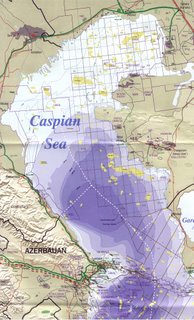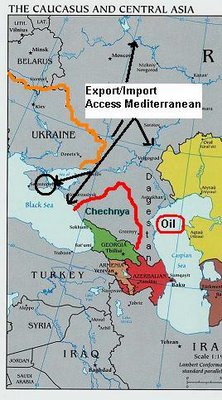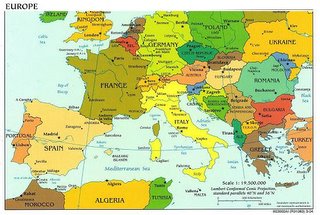Russian Intelligence Chief: U.S. Bases Near Russia a 'Threat'
MOSCOW — Russia's foreign spy chief said military forces from other countries deployed at bases along Russia's periphery are a threat to the nation, a Russian news agency reported Monday.
In comments that appeared directed at U.S. forces deployed on bases in former Soviet countries, the Interfax news agency quoted Sergei Lebedev, head of the Foreign Intelligence Service, as saying that Russia no longer had a "main adversary" as during the Cold War.
But "Russians cannot help but be concerned about new military bases and military contingents being deployed around our country," he was quoted as saying.
Why does Russia consider US bases in the Caucuses a "threat" to Russian Security if we are no longer a "main adversary" as "during the Cold War"?
The United States has no plan or desire to invade Russia, so the threat is not "physical" in nature. The problem revolves around three issues:
1)Land
2)Resources
3)Economy
Which equates to stability in Russia.
Quite simply, Russia fears losing influence over these nations that are quickly being integrated, not only into NATO related nations, but economically towards the west.
These maps may explain the situation more succinctly:

On the map, the Ukraine is outlined in orange and has recently oriented to the west and NATO. The area outlined in red is actually Chechnya, Ingushtiya and North Ossatia, all of which have Islamist activity. Dagestan has also made some noise towards independence with some bleed over of Islamist movements from Chechnya. Georgia in lime green is also a US and new NATO oriented country. Azerbaijan, shaded red, has made several democracy noises, though weak, which has made Russia nervous as well. Kazakhstan, Turkmenistan, Kyrgyzstan and Tajikstan are all having democracy movements. Turkmenistan, Kyrgyzstan and Tajikstan are all hosting US forces, assisting with Operation Enduring Freedom in Afghanistan.
The most important aspects of this area are the oil deposits in the Caspian Sea and access to the Black Sea which allows access to the Mediterannean Sea through the Bosporus s Straits in Turkey for import and export of goods including oil and natural gas. This access also includes ports on the Sea of Azov (black circle, Crimean Peninsula) and the Black Sea for the Russian Navy, also providing access to the Mediterranean and out to the Atlantic or down through the Suez Canal.
Oil exports are a major source of revenue for Russia:
EIA Analysis Russia -In 2004, Russia’s real gross domestic product (GDP) grew by approximately 7.1%, surpassing average growth rates in all other G8 countries, and marking the country’s sixth consecutive year of economic expansion. Russia’s economic growth over the last five years has been fueled primarily by energy exports, particularly given the boom in Russian oil production and relatively high world oil prices during the period.
This type of growth has made the Russian economy dangerously dependent on oil and natural gas exports, and especially vulnerable to fluctuations in world oil prices. Typically, a $1 per barrel change in oil prices will result in a $1.4 billion change in Russian revenues in the same direction—a fact that underlines the influence of oil on Russia's fiscal position and its vulnerability to oil market volatility
 Click to enlarge.
Click to enlarge.This map shows the oil drilling and distribution of deposits in the Caspian Sea between the bordering nations. The EIA analysis continued:
in 2003, Russia was the world’s second largest producer of crude oil, behind only Saudi Arabia. From March to May 2004, Russian crude oil output actually exceeded that of Saudi Arabia.[snip]Although Russia produces almost 7 million bbl/d of liquids for export, only about 4 million bbl/d can be transported in major trunk pipelines; the rest must be shipped by rail and river routes. Most of the 4 million bbl/d transported via alternative routes are petroleum by-products (see Fig. 2b).

After Russian oil flows through the various pipelines described above, some crude oil and products are shipped onward to Europe, the United States, and Asia via tanker. The bulk of Russia's oil is shipped to the Mediterranean and to Asia via tankers in the Black Sea, mostly from the port of Novorossiysk. With the opening of the BTC pipeline in 2005 and the higher export aspirations of the CPC consortium owners (see the Caspian and Kazakhstan briefs, respectively), it is now unclear how much oil will still be shipped out of the Black Sea ports. Since the economic viability of the BTC pipeline is as of yet untested, some analysts expect Novorossiysk (along with Batumi, Supsa, and Odessa) to remain at current levels (approximately 1.7 million bbl/d in 2003). Other analysts expect that if Azerbaijan does actually divert all of its oil shipments via BTC, the exports from Novorossiysk will decrease
While the sea ports and access to the Mediterranean were the reason that Peter the Great and Catherine the Great both waged war against the Ottoman Empire and Tsar Nicholas I fought the Crimean War where he sought control of neighboring Bulgar Ottoman states, later discovery of petroleum put a whole new emphasis on the importance of the region to Russia's survival. During WWII, Hitler attempted to drive to the Caucuses in order to both bolster Nazi Germany's control of oil resources and reduce Russia's resources to commit war. The Battle of Stalingrad (now Volgograd on the map above) ended in defeat.
 Stalin accused Chechens of collaborating with the Nazis during this time and proceeded to massacre and relocate the population; one of the many remembered assaults that continues to fuel the Chechen insurgency which began in 1991 when Chechnya attempted to declare independence with other former Soviet Republics. Moscow claimed that the Chechnyan constitution did not provide for seceding from Russian and began a long and costly war to hold on to the area. However, the main rejection of independence for this area was related to the oil deposits, pipelines and railroads vital to Russian economic stability. It is believed that the Islamist movement in the rebellion did not begin until approximately 1996 after Russia's failed attempt to take Grozny that resulted in thousands of deaths among civilians (as the result of fighting and ethnic cleansing by both sides).
Stalin accused Chechens of collaborating with the Nazis during this time and proceeded to massacre and relocate the population; one of the many remembered assaults that continues to fuel the Chechen insurgency which began in 1991 when Chechnya attempted to declare independence with other former Soviet Republics. Moscow claimed that the Chechnyan constitution did not provide for seceding from Russian and began a long and costly war to hold on to the area. However, the main rejection of independence for this area was related to the oil deposits, pipelines and railroads vital to Russian economic stability. It is believed that the Islamist movement in the rebellion did not begin until approximately 1996 after Russia's failed attempt to take Grozny that resulted in thousands of deaths among civilians (as the result of fighting and ethnic cleansing by both sides).The status of Chechnya is still in limbo as both the rebels and Moscow attempt to control the politics and elections.
For the Islamists, the hope was to begin an Islamic revolution throughout the 'Stans, including Dagestan as well as Azerbaijan, to connect with Afghanistan, creating an arch of Islamist countries through out the Caucuses, taking control of the oil fields and seaports, in order to build the first stage of the Islamic Republic, encircling Iran and pushing down through the Middle East to the heart of the old Caliphate and eventually down to the Arabian Peninsula and North Africa (Egypt). This was probably based on a calculation that Russia was too weak militarily and economically to put up much of a fight. Destabization or control of the region would have completed the economic destruction of Russia and seriously damaged western and Asian finances and energy stability.
In short, the Caucuses represent both "national security" constructs for Russia:
1) Protecting borders, citizens and internal resources
2) Protecting the international interests including access to trade routes, ports, resources, trade agreements and allies.
Land + Resources = Economy = Survivability
 Russia's relationship with Iran is more than a question of revenue from building a nuclear facility although, building nuclear power plants for nations has been a vital source of income. However, the Iranian paradigm includes:
Russia's relationship with Iran is more than a question of revenue from building a nuclear facility although, building nuclear power plants for nations has been a vital source of income. However, the Iranian paradigm includes:1)Protection of Russian interests in the Caspian Sea
2)Economic partner in the transportation of natural gas and oil through Russian pipelines, railroads and sea ports.
3)Non-energy trade
4)Cooperation in the production rate of oil, stabilizing or increasing the price of oil to help maintain the current Russian growth rate (which in turn promotes investment in the nation and helps offset the economic vulnerability brought on by reliance of energy exports). This also gives Russia a foot in with the OPEC nations when making decisions on oil output and controlling prices.
This last item also explains Russia's concerns with the orientation of the former central Asian Soviet Republics towards the west since loss of cooperation and increased western drilling threatens to decrease the price of oil through increased production and export, stunting Russia's GDP growth, weakening the state, instigating economic failure and possibly resulting in additional "republics" breaking off. All of which would precipitate a continuing downward spiral to a failed state.
A failed Russian state is not in the interest of the United States however their continuing relationship with Iran and insistence on providing nuclear material and assistance to build nuclear facilities might vex us.
 However, the United States continues to move to closer relationships with many of these states as well as Georgia, Ukraine and the former Warsaw Pact nations of eastern Europe while simultaneously pushing the European Union to allow Turkey to join. All of these movements are made to open up and liberalize export of energy resources to slow the inflation of oil prices; offset the impact and control of OPEC nations on oil supply and prices; and offset the growing consumption of oil by emerging economies in the Balkans, Eastern Europe and Asia (namely China). This also provides additional emerging markets for import and export of non-energy products.
However, the United States continues to move to closer relationships with many of these states as well as Georgia, Ukraine and the former Warsaw Pact nations of eastern Europe while simultaneously pushing the European Union to allow Turkey to join. All of these movements are made to open up and liberalize export of energy resources to slow the inflation of oil prices; offset the impact and control of OPEC nations on oil supply and prices; and offset the growing consumption of oil by emerging economies in the Balkans, Eastern Europe and Asia (namely China). This also provides additional emerging markets for import and export of non-energy products.For Russia, the liberalization of these markets presents a major problem since their influence on production and export, thus, price, helps maintain current oil prices and GDP growth. Russia will continue to need the revenue from high oil prices to stabilize their economy until they can improve "other than energy" industry and imports, balancing their economy and not be constantly on the brink of disaster by potential or continuing war with rebel provinces or economic crisis in China (slowed growth), East Europe (eventual slowing growth) or Europe proper (currently suffering poor economic growth) that would decrease demand of oil and send Russia's economy crashing.
Further, democratization and liberalization may spark independence movements in its remaining Caucus states that will cut off access to the Caspian and Caucus energy reserves and access to ports, pipelines and railroads. Again, sparking an economic crisis.
The United States has made continued overtures and efforts to get Russia to liberalize and privatize its energy sources. After the fall of the Soviet Empire, the Russians did that with disasterous results, which it is not keen on repeating. The main problem was that corruption was so rampant, and the judiciary so weak and on the dole from crime bosses (or just plain afraid of assasination by the Russian mob), tax law could not be enforced, state revenues went out the window and the Russian economy collapsed. Putin is now using laws to prosecute the "oil pirates" and renationalize energy businesses.
Unfortunately, the use of state control as seen in the Communist period is a vicious circle:
Privatization "did not markedly improve the efficiency" of domestic Russian firms in the past decade, conclude three University of Michigan economists in a recent paper. Those firms are not catching up to world standards and are falling further behind.
"It's saying that privatization didn't work," says Katherine Terrill, one of the coauthors. "That's depressing."
By contrast, those firms with some foreign investor involvement have increased their productivity faster than those owned and managed by Russians alone, the professors' research shows.
This leaves Russia's economic leadership in a quandary. Nationalistic and political sentiments call for retaining or winning control of key elements of the economy. Yet managers of purely domestic firms appear to be slower than those running foreign-influenced firms in learning the skills and technology that can keep them in the economic race.[snip]
Progress may be difficult. The Yukos-Khodorkovsky affair has damaged Russia's reputation as a place to invest, despite Putin's efforts to reassure US and German executives. So far, foreign direct investment remains relatively tiny. The Organization for Economic Cooperation and Development counts only a $16 billion inflow over the past four years.
Of course, Mr. Putin's tendency to nationalize any industry that seems to be performing above expectations would also make investors extremely leery since nationalized industries mean these investors do not get their investment or expected profits back. Which means other non-energy industries do not get needed investment, cannot improve efficacy or profits, thus, Russia's economic growth continues to fluctuate:
Putin has announced the goal of doubling Russia's GDP in 10 years. That would require 7 percent annual growth after adjusting for inflation. If achieved, that goal would lift Russian living standards to that of Portugal - one of Western Europe's poorest nations.[snip]
More ominously, the growth in oil production has slipped. After a 13 percent surge in 2003, growth slowed to maybe half that pace last year and is even slower so far this year, despite prices around $60 a barrel.
Although Russia is not alone in its concern for the amount of foreign investment or ownership in energy sources, its clear that some sort of privatization and stronger laws protecting property rights will be necessary in order to develop Russia's economy fully.
Operation Enduring Freedom provided an opportunity for the Central Asian states and the United States to begin to work together on security matters. Once that was in place, these nations could feel comfortable that the US was not going to abandon them while they moved towards democracy and liberalized markets. This cooperation in security also provided mutual economic benefits in regards to energy and other imports and exports. At the same time, the continuing overwhelming presence of US forces has made Russia uneasy. The United States has made efforts to obtain increased NATO troops and reduce its foot print in the area while still guaranteeing security and economy to the Central Asian states.
Operation Iraqi Freedom has resulted in similar concerns for Russia, but are more reflective of its concerns that Iraq, allied with the United States and a member of OPEC, would be able to apply more pressure on other OPEC nations, influence production of these states or increase its own, influencing the price of oil. This also plays into the Russian-Iran matrix where Russia is willing to provide technical assistance to build nuclear facilities and provide fuel in order to build additional influence with Iran as its influential partner in OPEC. Further, this partnership, with Russia controlling the nuclear fuel rods means that, even if Iran vacates its obligations under the Non-Proliferation treaty, Russia is willing to bet that Iran's ability to produce enough nuclear material or weapons to threaten Russia or its interests will be extremely limited by its own arsenal and economic MAD (Russian imports in Iran are 10 times Iranian exports; pipelines to Europe go through the Central Asian and Russian pipelines).
At the same time, the existence of a nuclear Iran means that US oriented Saudi Arabia as the highest producer and most influential partner in OPEC will be undermined as Iran becomes the military power in the region. If the Iranian influenced Shi'ite parties in Iraq are able to form the governing power and maintain power, then Iran, thus Russia, will have the major influence in OPEC. The French, German and British understood this as well and hoped to complete similar influence with Iran within Opec and open oil production in the state to help increase their own revenues and energy resources, but with guarantees of non-proliferation. However, both Russian offers to provide fuel and the EU3 were rebuffed by Iran who responded by electing a hardline President,Mahmoud Ahmadinejad, who has now called for Israel to be destroyed, insisted that the holocaust of Jews was a myth and stated uncategorically that it was Iran's right to have nuclear power. There are numerous reports that he has also insisted that Iran has the right to nuclear weapons to protect itself from US or Israeli aggression.
Some experts see this as political posturing in order to strengthen Iran's position and shake off constrictions by increasing pressure from Russia, EU3 and the presence of the United States on two of its borders. This continued friction has led some to claim that Iran is supporting the Shi'ite political parties and militias responsible for killing many Sunni leaders and citizens. This same concern of Iranian power has most likely led to Syria, Jordan and Saudi Arabia being lax on security, who enters and leaves their country for Iraq, in order to shore up their own positions with the Sunni and offset Iranian power.
These underlying currents are what drives some critics of the Unites States and the Bush administration to claim that both Afghanistan and Iraq were "war for oil" and that the terrorist threat was conflated in order to take advantage of the situation. However, the administration has repeatedly reminded people that the 9/11 attacks were unprovoked, killed 2987 people and required a response. Further, Gen. Tommy Franks in his book, "American Soldier", indicated that contacts with the Central Asian nations had been extremely limited (if not non-existent) until approximately six weeks prior to the opening of the war and that it took a lot of effort, a lot of guarantees and even a lot of money to convince the Central Asian states to assist by providing secure bases in their countries.
Further, the administration believes that, after 9/11, the fact that Saddam Hussein's regime had broken numerous UN resolutions, had continued to break cease fire agreements, had been believed to posses WMD by many nations, was known to have used it and known to have ties with terrorist organization, that Iraq presented a threat to the US on its borders through supporting terrorists physically, materially and monetarily and that he presented a threat to United States interests by threatening US allies and "interest" (ie, oil, gas and control of trade routes). All other activities and political issues are "fallout" requiring diplomatic solutions as opposed to pre-planned activities for a specific outcome. Further, the United States believes that liberalization, not just of markets, but of governments, will lead to increased stability and evetually decrease extremist ideology.
In any case, from Afghanistan to Iraq, the United States' efforts have created a ripple across the entire Eastern hemisphere, both economically and politically, by supporting liberal democratic movements and liberalization of markets, not only in these two states, but surrounding neighbors and allies from the Central Asia, to the Gulf States, to Saudi Arabia, Egypt, Palestine and Lebanon.
The question is whether this will be enough to stabilize world oil production and prices, offset consumption, improve and open liberal markets, increase accountability, increase self rule and freedom, stabilize the region and increase security both within the borders of the United States and the interests of the United States.
It's a tall order for two ripples in the ocean.
Maps courtesy of University of Texas Library
(click "read more" to "read more")




















No comments:
Post a Comment